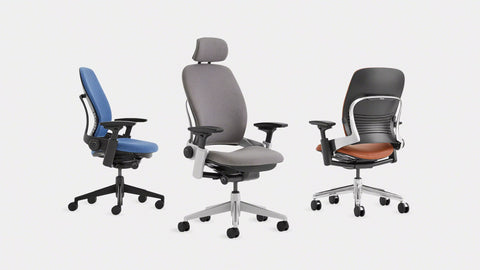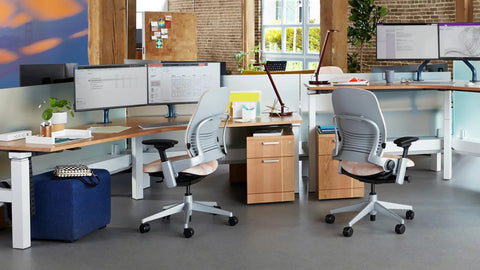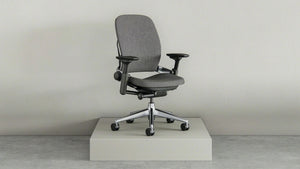This article is a part of "Office Chairs Hall of Fame" article series.
Introduction
In the rich tapestry of office furniture evolution, few pieces stand out as prominently as the Steelcase Leap. This isn't merely a chair; it's a testament to the culmination of design, ergonomics, and an acute understanding of the human body in the workplace. Born at the cusp of the new millennium, the Steelcase Leap was more than a product – it was a response to a shifting global workforce and an acknowledgment of the deep-seated need for healthier, more dynamic seating solutions. As the world rapidly transitioned into a digital era, with burgeoning technological advancements and changing workplace dynamics, the Leap emerged not just as a seating option but as a symbol of adaptability and foresight. Dive with us into the world of the Steelcase Leap, a chair that redefined office ergonomics and set new benchmarks for future innovations.

The Leap's Historical Context
In the late 1990s, the corporate world was undergoing significant change. Technology was becoming integrated into everyday tasks, leading to more desk-bound jobs and longer hours spent in front of computer screens. This shift intensified concerns about the health implications of prolonged sitting, ushering in a growing demand for office furniture that prioritized comfort and ergonomics.
Introduced in 1999, the Steelcase Leap was a timely answer to these evolving needs. But it wasn't a mere response; it was a pioneering step forward. Instead of simply crafting a chair that was comfortable, Steelcase embarked on an ambitious four-year journey to understand how people sit. They observed over 700 users, leading to numerous insights about individual and collective sitting patterns.
For instance, they found that people change their posture almost 40 times an hour, underscoring the need for dynamic seating solutions. The traditional static chair models were proving to be inadequate. Armed with these insights and driven by a vision to redefine ergonomic seating, Steelcase set out to design the Leap.
This was no ordinary chair. It was the embodiment of countless hours of research, observation, and relentless testing. The Leap wasn’t just created to fill a gap in the market; it aimed to set a new standard, signaling a profound shift in how the industry approached office seating.

The Design Philosophy
The Steelcase Leap wasn’t crafted on a whim or drawn from mere aesthetic inclinations. Instead, it was the result of a deep and introspective journey into the nuances of human anatomy and behavior. Every curve, pivot, and material choice was steeped in a profound understanding of how people inhabit their workspaces.
Central to the Leap's design ethos was adaptability. Recognizing the fluidity of human motion and the myriad postures one assumes throughout a workday, the chair was conceived to be as dynamic as its user. The belief was clear: seating should not impose a posture but rather support the user's natural movements.
The "LiveBack" technology epitomizes this philosophy. Born from extensive research, it's more than just a feature—it's a manifestation of the chair's spirit. The Leap doesn’t ask its user to adjust to it. Instead, it morphs and contours in real-time, offering unparalleled support regardless of the user's position.
In essence, the Leap's design is a harmonious dialogue between form and function, where aesthetics don't compromise comfort, and ergonomics elevate the visual appeal. It's a chair where science meets art, all guided by a singular vision: to redefine the very essence of what an office chair could be.
The Mastermind(s) Behind the Magic
While the Leap stands as an icon of ergonomic brilliance, its creation was not the work of a singular genius, but rather a collaborative symphony of innovators at Steelcase. These were minds deeply attuned to the intricacies of human behavior, especially within the confines of a workspace. They believed that an office chair wasn't just a passive tool but a dynamic extension of the user.
At the heart of their innovative journey was an insatiable curiosity. They questioned age-old norms of chair design and sought to understand the myriad ways people interacted with their seating throughout a workday. Through countless observations and feedback loops, they uncovered the nuances of human posture and movement.
This wasn’t a mere design endeavor. It was a holistic approach that married science, ergonomics, and artistry to craft a chair that was not only functional but also intuitively responsive. The team at Steelcase didn't just design a chair; they sculpted an experience, ensuring that every subtle movement, every shift and tilt, was met with a corresponding response from the Leap. The result was a piece of art that breathed with its user, a testament to the genius of collective innovation at Steelcase.
Impact on the Industry
The launch of the Steelcase Leap was more than just the introduction of another office chair; it was a statement. It signaled the industry's shift towards prioritizing ergonomics and personalized comfort.
The Leap became a benchmark for other manufacturers. Its success story underscored the importance of research-driven design and paved the way for other innovative chairs that prioritize individual ergonomics over a one-size-fits-all approach.

Features at a Glance
The Steelcase Leap isn't just recognized for its aesthetics or its pioneering role in ergonomic seating. At its core, a series of meticulously designed features propel it to the forefront of office seating. Each feature is not just an added bonus, but a careful integration that adds to the holistic experience of the user. Here’s a closer look:
-
LiveBack Technology: Beyond mere lumbar support, the Leap's backrest dynamically adjusts to the intricate movements of the user's spine. It's not just about sitting; it's about moving while seated, and the chair responding in kind.
-
Natural Glide System: The art of reclining is reimagined. As users lean back, the system ensures they remain oriented towards their work, maintaining an optimal viewing angle and distance from their workstation.
-
Thermal Comfort: More than just breathability, the Leap uses advanced materials that regulate temperature, ensuring the user remains cool and comfortable, even during prolonged periods of use.
-
Sustainable Design: Beyond its ergonomic prowess, the Leap showcases Steelcase's commitment to the environment. Crafted with up to 94% recyclable materials, it underscores the possibility of melding top-tier design with eco-consciousness.
-
Customizable Adjustments: Recognizing the individuality of each user, the Leap boasts features like height-adjustable armrests, variable seat depth, and tailored lumbar support. This ensures a bespoke seating experience tailored to each individual's unique physique and preferences.
This suite of features ensures that the Leap isn’t just a passive piece of office furniture, but an active participant in the user's workday, enhancing comfort, productivity, and well-being.
Conclusion
The Steelcase Leap is more than an exemplar of ergonomic design; it stands as a beacon of how in-depth research, ingenuity, and an unwavering commitment to user well-being can revolutionize an industry. Beyond its groundbreaking features and aesthetic appeal, the Leap tells a story of a shift in perspective. It underscores a world where office furniture isn't just about furnishing a space but enhancing the quality of life for those within it. As we spotlight the Leap in our "Office Chairs Hall of Fame," we don't just honor a product; we celebrate a paradigm shift, a vision that has forever altered our understanding of comfort and productivity in the workspace. It is a reminder that when design meets empathy, masterpieces are born.

